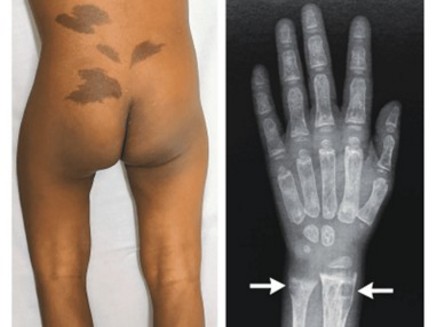(Precocious puberty independent of gonadotropins in girls, fibrous polyostotic dysplasia)
Estimated prevalence: 1-10/106. Postzygotic somatic mutation of the activating protein Gs (GNSA1 gene on 20q13.32) resulting in mosaicism which explains the heterogeneity of signs.
There is classically a triad of signs:
- highly vascularized fibroosseous dysplasia (especially at the level of the long bones), source of pathological fractures;
- precocious puberty related to very early and recurrent ovarian cysts (before 4 years);
- cafe au lait spots of metameric topography with random edges appearing as soon as the neonatal period.

Source: NEJM Nov 9, 2024
The classical form includes at least two elements of the triad. Sometimes, precocious puberty is isolated. Other endocrine anomalies may be associated: hyperthyroidism, hyperparathyroidism, hyperadrenocorticism, hyperprolactinemia.
Neonatal forms can cause intrahepatic cholestasis, hypercortisolemia, or hypertrophic cardiomyopathy.
Medical treatment for progressive precocious puberty: (testolactone) aromatase inhibitors.
Anesthetic implications:
full endocrine checkup. Special precautions for positioning (risk of fracture, osteopenia by endocrine disorders); possibly difficult ventilation or intubation in case of fibrous bone dysplasia of the face. High risk of hemorrhage in case of resection of the dysplastic tissue.
References :
- Langer RA, Yook I, Capan LM.
Anesthetic considerations in McCune-Albright syndrome : case report and literature review.
Anesth Analg 1995; 80: 1236-9.
- Bohman JK, Segura L, Grim K.
Awake tracheal intubation in an 8-year-old girl with McCune-Albright syndrome.
Anesth Analg Case Reports 2013; 1: 23-5.
- Oesterling AE, Hansen BE.
Severe intraoperative hemorrhage during craniectomy in a patient with polyostotic fibrous dysplasia.
Anesthesiology 2020, 133:1261-2
Updated: November 2024